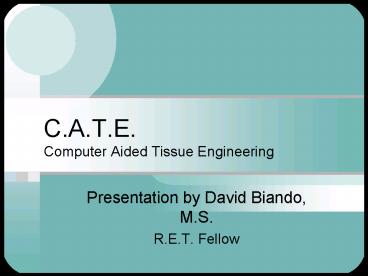C'A'T'E' Computer Aided Tissue Engineering - PowerPoint PPT Presentation
1 / 19
Title:
C'A'T'E' Computer Aided Tissue Engineering
Description:
Computer Aided Tissue Engineering. Presentation by David Biando, ... Computer Aided Tissue Engineering. Contents. CATE. Objective. Definitions. Goals. Obstacles ... – PowerPoint PPT presentation
Number of Views:514
Avg rating:3.0/5.0
Title: C'A'T'E' Computer Aided Tissue Engineering
1
C.A.T.E.Computer Aided Tissue Engineering
- Presentation by David Biando, M.S.
- R.E.T. Fellow
2
C.A.T.E.Computer Aided Tissue Engineering
- Contents
- CATE
- Objective
- Definitions
- Goals
- Obstacles
- Biandos Research Project Hypotheses
- Modular Scaffold and Interconnectivity
- Fibonacci Sequence
- Procedures
- Classroom Lessons
- Introduction to Engineering and other
Interdisciplinary Fields like Bioengineering. - Introduction to CAD modeling software.
3
C.A.T.E.Computer Aided Tissue Engineering
- CATE
- Objectives The intention of this presentation is
essentially meant to serve three purposes - Introduce CATE to you.
- Inform you of my research.
- Share some insight with you.
4
C.A.T.E.Computer Aided Tissue Engineering
- CATE
- B. Definitions Tissue Engineering is an
interdisciplinary field consisting of engineers
working with biologists and medical scientists
searching to replace or improve the function of
tissues and organs, which have lost function due
to trauma, illness, aging or congenital diseases,
through the application of biomaterials and
procedures that work with the natural rebuilding
processes and technology.
5
C.A.T.E.Computer Aided Tissue Engineering
- CATE
- C. Goals
- Challenges of Interdisciplinary Fields
- BioMedical Life scientists, biochemists, and
geneticists are going to play a large part in the
overall success of tissue engineering. We need to
better understand the basis of life at the
sub-molecular level in order to be successful.
Understanding all the necessary requirements,
environments, chemistry, and mechanisms of a cell
is essential for all parties involved in tissue
engineering. This may be one of our biggest
challenges in tissue engineering. - Focuses Stem cell research, DNA sequence decoding
6
C.A.T.E.Computer Aided Tissue Engineering
- CATE
- C. Goals
- Challenges of Interdisciplinary Fields
- BioTechnology In order to be successful
engineers will need to improve and develop new
technological tools specifically for the purpose
of tissue engineering. Computer aided design
(CAD) software programs will need to be able to
handle complex algorithms to model and predict
the behavior of cells under different conditions
and work on heterogeneous structures. - Focuses (BioCAD)
7
C.A.T.E.Computer Aided Tissue Engineering
- CATE
- C. Goals
- Challenges of Interdisciplinary Fields
- BioTechnology Non-invasive imaging systems need
to be developed in order to obtain increased
information about the processes and behavior of
tissue regeneration in vivo. - Focuses Improved CT/MRI Imaging (mCT/mMRI),
endoscopic or development SLS (see through)
scaffold materials, nano-probes.
8
C.A.T.E.Computer Aided Tissue Engineering
- CATE
- C. Goals
- Challenges of Interdisciplinary Fields
- BioEngineering Development of tissue scaffolds
and development of fabrication and manufacturing
processes. - Focuses Accurate biomimetic modeling, Boolean
operations, improved computer-aided tissue
informatics, SFF technology, smart scaffold
design, improved 3D cell and organ printing and
scaffold fabrication devices.
9
C.A.T.E.Computer Aided Tissue Engineering
- CATE
- D. Obstacles
- Challenges to Tissue Engineering
- Biological Issues
- DNA Decoding
10
C.A.T.E.Computer Aided Tissue Engineering
- CATE
- D. Obstacles
- Challenges to Tissue Engineering
- Biological Issues
- DNA Decoding
- Cell Growth Control
11
C.A.T.E.Computer Aided Tissue Engineering
- CATE
- D. Obstacles
- Challenges to Tissue Engineering
- Biological Issues
- DNA Decoding
- Cell Growth Control
- Immune Rejection
12
C.A.T.E.Computer Aided Tissue Engineering
- CATE
- D. Obstacles
- Challenges to Tissue Engineering
- Biological Issues
- DNA Decoding
- Cell Growth Control
- Immune Rejection
- Vascularization
13
C.A.T.E.Computer Aided Tissue Engineering
- CATE
- D. Obstacles
- Challenges to Tissue Engineering
- Technological Issues To support and guide the
development and growth of cells into desired
tissues, scaffolds have to be designed that
provide the right environment for cell
attachment, cell growth and vascularization to
take place. - Biological unknowns (as stated previously)
- Cart before the horse
- Non-invasive imaging systems need to be developed
- Inadequate CAD capabilities
14
C.A.T.E.Computer Aided Tissue Engineering
- CATE
- D. Obstacles
- Challenges to Tissue Engineering
- Technological Issues To support and guide the
development and growth of cells into desired
tissues, scaffolds have to be designed that
provide the right environment for cell
attachment, cell growth and vascularization to
take place. - Biological unknowns (as stated previously)
- Cart before the horse
- Non-invasive imaging systems need to be developed
- Inadequate CAD capabilities
15
C.A.T.E.Computer Aided Tissue Engineering
- CATE
- D. Obstacles
- Challenges to Tissue Engineering
- 3. Ethical Issues
- Political Climates
- Religious Foundations
- Fear of the Unknown
- Frankenstein Syndrome
16
C.A.T.E.Computer Aided Tissue Engineering
- II. Biandos Research Project Hypotheses
- Modular Scaffold and Interconnectivity
- Developing a tissue scaffold that is modular in
design and connects to other similar scaffolds by
a interlinking system will allow for easy access
and observation which will increase bioinfomatics
with regards to cell livelihood, migration and
behavior while in an invitro state.
17
C.A.T.E.Computer Aided Tissue Engineering
- II. Biandos Research Project Hypotheses
- Modular Scaffold and Interconnectivity
- Fibonacci Sequence
- Designing a tissue scaffold that employees
Fibonacci Sequence would be a more accurate
biomimetic model and would allow for better cell
formation and migration.
18
C.A.T.E.Computer Aided Tissue Engineering
- II. Biandos Research Project Hypotheses
- C. Procedures
- 1. Learn more CAD programs
- 2. Continue to research hypotheses
- 3. Design scaffolds employing hypotheses
- 4. Test design types by introducing cells
and measuring results. - 5. Draw conclusions
19
C.A.T.E.Computer Aided Tissue Engineering
- III. Classroom Lessons
- Introduction to Engineering and other
Interdisciplinary Fields like Bioengineering. - Introduction to CAD modeling software.

